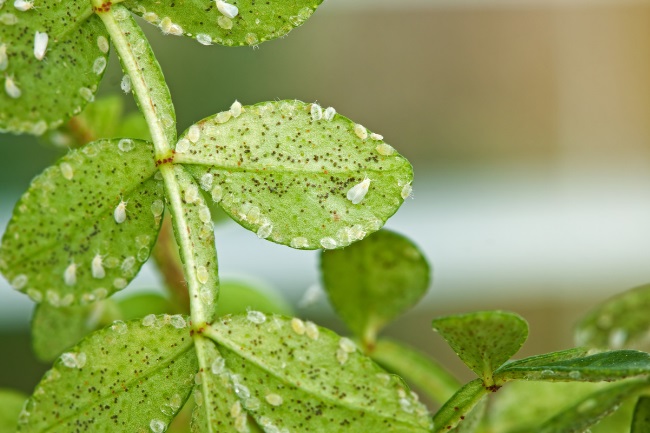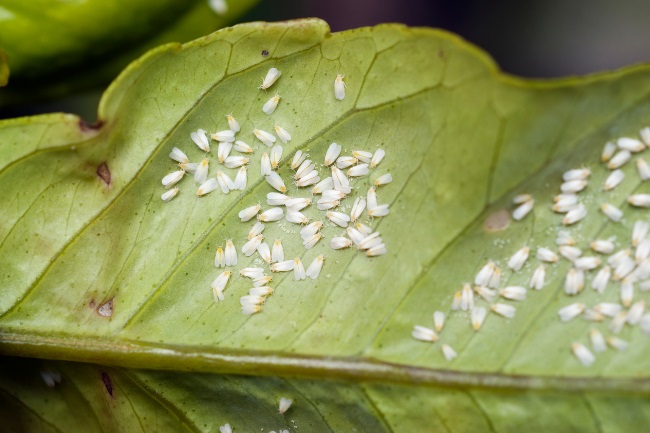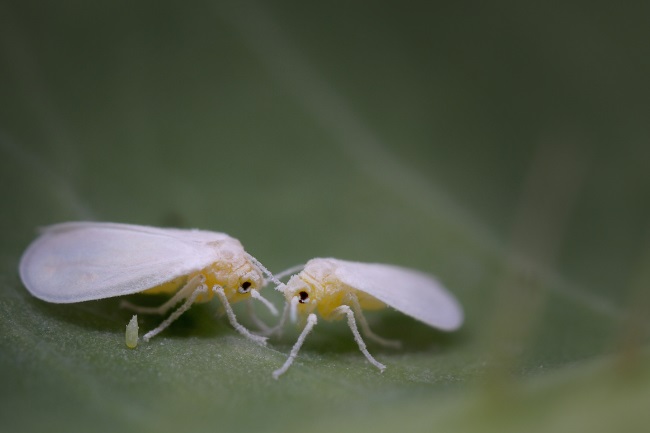Whiteflies are difficult to get rid of. However, there are a number of techniques you can try both to wipe out these pesky insects and to prevent them from infesting the plant in the first place. Encouraging predators into your garden, such as ladybirds, can be the most effective deterrent.
Contents
What causes whiteflies on plants?
Whiteflies are common insects, which feed on sap. The adults can fly and will move into a healthy plant to lay their eggs. Once the eggs hatch, the young will remain attached to the plant feeding until they pupate and become adults, flying off to a new location.
Do whiteflies kill plants?

Whiteflies feed on the plant’s sap, both in their larval form and as an adult. As female whiteflies can lay between 200-400 eggs at a time, whitefly infestations can often mean a great deal of sap is being consumed. This weakens the plant, causing it to sag or for leaves to turn yellow and fall off. Generally, this feeding isn’t enough to kill the plant directly, but it will often leave it vulnerable to other diseases.
Additionally, whiteflies can cause the plant to become infected by transferring bacteria and other illnesses from other plants via their spit when they cut into the plant and begin to feed. However, the most common issue is the spread of moulds, caused by the excretion of honeydew by the whiteflies, both as adults and as nymphs.
This sweet and sticky liquid is a waste product produced by these insects to eliminate unwanted liquids and sugars. It coats the leaves of the plant they are feeding on and provides the perfect food for fungi spores. Some animals also feed on this waste product, such as ants, and will even protect the juvenile whiteflies from predators in order to harvest their honeydew.
Overall a whitefly infestation can leave plants weakened and suffering from a number of ailments caused by this parasites activities. In the long-term, if this continues, this can lead to the plant dying.
Also read: Are Whiteflies Harmful to Humans? (or Pets?)
What do whiteflies do to plants?
Whiteflies are a member of the true bug group; this means they have piercing mouthparts known as stylets. They use these to pierce the xylem of the plant and suck out the sap. They will do this almost constantly from when they hatch until they die.
How to remove whiteflies from plants?

Whiteflies are incredibly difficult to get rid of once they have infected a plant. It is best to inspect plants regularly to check for whitefly eggs so they can be removed before hatching. Whitefly eggs are a yellowy-white colour and are long and tapering at each end. They are often laid in circular patterns and will turn brown as they become ready to hatch.
| Natural Remedy | Description |
|---|---|
| Neem Oil | Neem oil acts as a repellent and disrupts the growth and feeding patterns of whiteflies |
| Insecticidal Soap | Insecticidal soaps are effective in suffocating and killing whiteflies while being safe for plants |
| Horticultural Oils | Horticultural oils smother whitefly eggs, nymphs, and adults, providing control and preventing further damage |
| Sticky Traps | Yellow sticky traps attract and capture adult whiteflies, helping to reduce their population |
| Companion Planting | Certain plants, such as marigolds and basil, can repel whiteflies when interplanted with susceptible plants |
Look out for small white flying insects, which fly away when disturbed, as these may be adults in the process of egg-laying. If eggs are found, the first port of call is to try and remove them. This can be done by blasting the underside of the leaf with a hose. A handheld vacuum cleaner can also be used, but be careful with delicate plants as the leaf may be damaged. It’s important to remember to dispose of the vacuum bag outside and not in the house, as the whiteflies may hatch and emerge later.
Once an infestation has begun, the best option is to wash the plant with soapy water. This will not hurt the plant. Ideally, do this later in the day when other insects are less active. Keep checking your plant for more signs of infestation and repeating the treatment if required. You can also remove any leaves with high levels of infestation to get rid of the large numbers of eggs or larvae.
How to prevent them from coming back?

In regions where winters are colder, with heavy frosts or snows, whiteflies cannot survive outside when the weather cools. However, in warmer climates or inside greenhouses, they can overwinter. It’s essential to check all plant you are bringing in from outside a growing area to ensure you aren’t bringing in whitefly eggs from elsewhere. Once they are in, they are hard to get rid of.
Another critical way to control whiteflies is to encourage those species that will eat them. Luckily whiteflies have a large number of predators, such as ladybirds, damselflies, lacewings and hoverflies. You can promote these species into your garden by planting native flowers, providing winter hibernation spots, such as log piles, and avoiding harmful chemicals.
| Prevention Measure | Description |
|---|---|
| Regular Inspection | Regularly inspect plants for signs of whitefly infestation, such as sticky residue or yellowing leaves |
| Pruning and Removal | Remove heavily infested leaves or plants to prevent the spread of whiteflies |
| Adequate Air Circulation | Provide proper air circulation around plants to discourage whiteflies, as they prefer still and humid environments |
| Consistent Watering | Avoid overwatering or underwatering, as whiteflies are attracted to stressed plants |
| Crop Rotation | Rotate crops to prevent the buildup of whitefly populations in the same area |
Companion planting can be another great way to avoid getting whitefly infestations. Certain plants give out chemicals that repel pests, such as French and Mexican marigolds and nasturtiums. You can also plant flowers that attach in whitefly predators, such as sunflowers, to attract ladybirds and lavender to bring in hoverflies.
If you are rearing plants inside a greenhouse, you can bring in predators such as ladybirds and lacewings to release into the greenhouse. These must be species native to the area, though, as they may escape into the wild.
One interesting technique to put off whiteflies is to lay out foil underneath the plants. The reflections off the foil can make it difficult for the whiteflies to find the plants to feed on.
One common solution many people use is to apply chemical pesticides. Yet, chemicals can have more negative effects than positive ones. Whiteflies are often quite resistant to these methods, Though the predators that eat them are more susceptible, this can mean that in the long run, you’ll end up with more whiteflies than before. Natural methods are way more sustainable and effective.
Plan ahead
These tiny insects are nothing if not annoying. Once they’re established, they can be hard to get rid of and can be devastating to plants. Your best method of defence is a good offence when it comes to these little creatures, so even if you don’t have whiteflies at the moment, it’s worth taking note of the various ways to dissuade them from becoming a problem and plan your planting around them. As with many natural problems, if you create a healthy ecosystem through your management, you’ll be able to balance the good with the bad, and hopefully, you’ll have enough natural predators to keep your pests in check.

